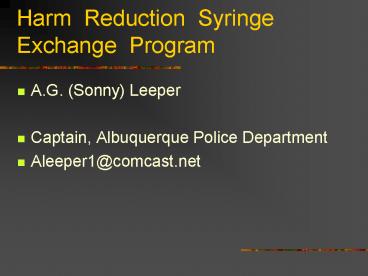Harm Reduction Syringe Exchange Program PowerPoint PPT Presentation
1 / 20
Title: Harm Reduction Syringe Exchange Program
1
Harm Reduction Syringe Exchange Program
- A.G. (Sonny) Leeper
- Captain, Albuquerque Police Department
- Aleeper1_at_comcast.net
2
New Mexico Harm Reduction Act of 1997
- Mandates that the New Mexico Department of Health
shall establish and administer a harm reduction
program for the purpose of sterile hypodermic
syringe and needle exchange - Started February 2, 1998 with 24 people
3
N.M. Harm Reduction Act Section 6
- Immunity from criminal liability
- 24-2C-6 (1997)
- Exchange or possession of syringes in compliance
with HRP shall not constitute a violation of the
Controlled Substances Act for a participant in
the program or a private provider whom the
department contracts with to operate the program
4
Purpose
- Reduce the number of used syringes in parks, and
on the streets - Refer participants to needed resources
- Move participants through the stages of change
toward treatment and abstinence
5
Enrollment Eligibility
- New Mexicans 18 years of age and older
- A person enrolling in the program must be a
current injection drug user
- The participant must be given a valid Yellow ID
Card with an individualized identification code
with an expiration date 1 year after enrollment
6
New Mexico
- 1994 to 1997 street based seroprevalence study
- 1003 IDUs in New Mexico
- .5 HIV positive
- 61 Hepatitis B positive
- 82 Hepatitis C positive
7
Why needle exchange is important to law
enforcement Personnel
- In 1995 almost 25,000 inmates in State and
Federal prisons were known to be infected with
HIV, Hepatitis B, or Hepatitis C - 82 of injection drug users in New Mexico have
Hepatitis C - The recidivism rate among drug users is more than
80
8
Importance to Law Enforcement Continued
- Post testing on blood stored a New York City
blood bank - HIV introduced to New York around 1976
- 9 in 1978
- 26 in 1979
- 38 in 1980
- Plateau in 1984 - 55 to 60
9
Risk to Law Enforcement
- It is estimated that a needle stick injury occurs
every 30 seconds. - 89 of all healthcare workers who have HIV-AIDS
and Hepatitis contracted the deadly disease due
to accidental needle sticks.
10
June 2004
- 8200 people are enrolled statewide
- Approximately 4000 are active participants
- Over 5 million needles exchanged since 1998
- 2 million of those in 2004
- 99 collection rate
- Over 30 sites statewide
- Only 1 are on the street in transition
11
Needle Stick Diseases
- Hepatitis
- Diphtheria
- Typhus
- Herpes
- Malaria
- HIV
- Malaria
- Tuberculosis
- Spotted Fever
- Syphilis
12
Needle Stick Diseases (cont.)
- There is no vaccine available for Hepatitis C and
no effective drugs to prevent the onset of the
disease once exposed - Hepatitis C is a major cause of chronic liver
disease - Hepatitis C is now the leading cause for liver
transplants in the US according to the NIH
13
Needle Stick Diseases (cont.)
- Of all the blood borne pathogens that can be
transmitted with needle sticks, HIV, HBV
(Hepatitis B), and HCV (Hepatitis C) pose the
greatest risk. - Once stuck with an infected needle there is a 30
chance of contracting HBV and a 10 chance of
contracting HCV - Up to 30 thousand a year for medicine to treat
HCV
14
Hepatitis in New Mexico
- 19,970 New Mexicans have tested positive for
hepatitis C - CDC estimates there are 32,000 New Mexicans that
have hepatitis C - There is no vaccine for Hepatitis C
15
Harm Reduction Site
- No using on or near the site
- No dealing or buying any drugs on or near the
exchange site - No alcohol or drugs at or near the site
16
Officer Safety
- A high risk of transmission of infectious disease
exists when personnel have contact with the
following groups - Illegal drug users
- Prostitutes
- Persons who state that they have Hepatitis B or
C, or HIV
17
Personnel at Risk
- Sworn Police
- Criminalistics personnel
- Evidence Technicians
- Service Aids
- F.I. Techs
- Reserve Officers
- School Detectives
18
At Risk Situations
- Anytime body fluids are present
- BODY SEARCHES
- Crime Scenes
- Searching personal effects ( purses, bags,
backpacks, etc.) - Extrication at auto accidents
19
Safety Precautions
- Wear gloves to reduce risk of a sharps stick
- All evidence or evidence that is suspected of
being contaminated must handled only when using
appropriate PPE - Needle exchange reduces the chance of the needle
being infected
20
QUESTIONS

